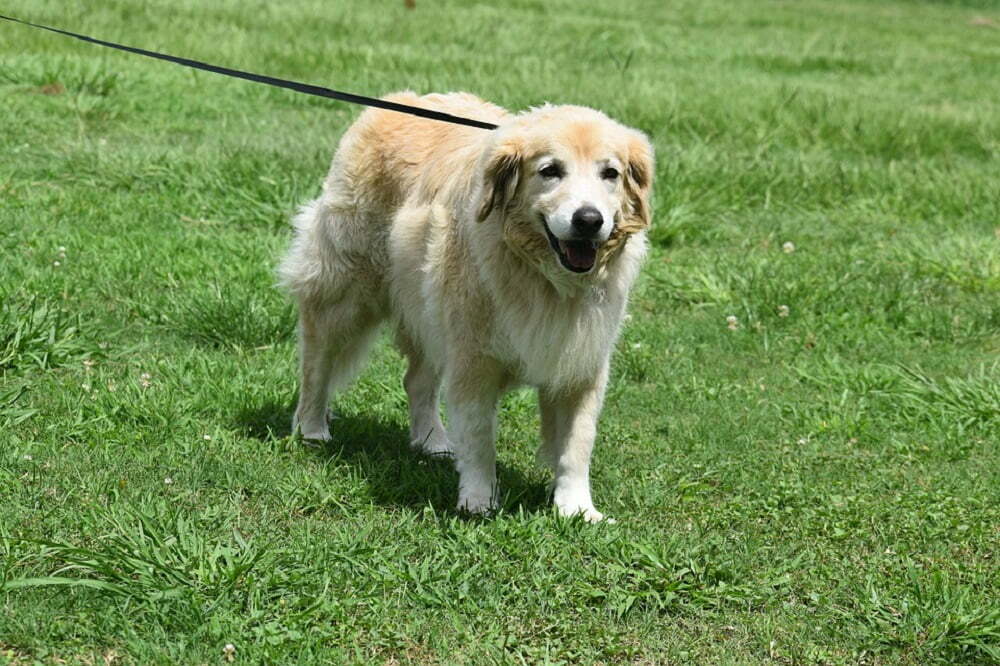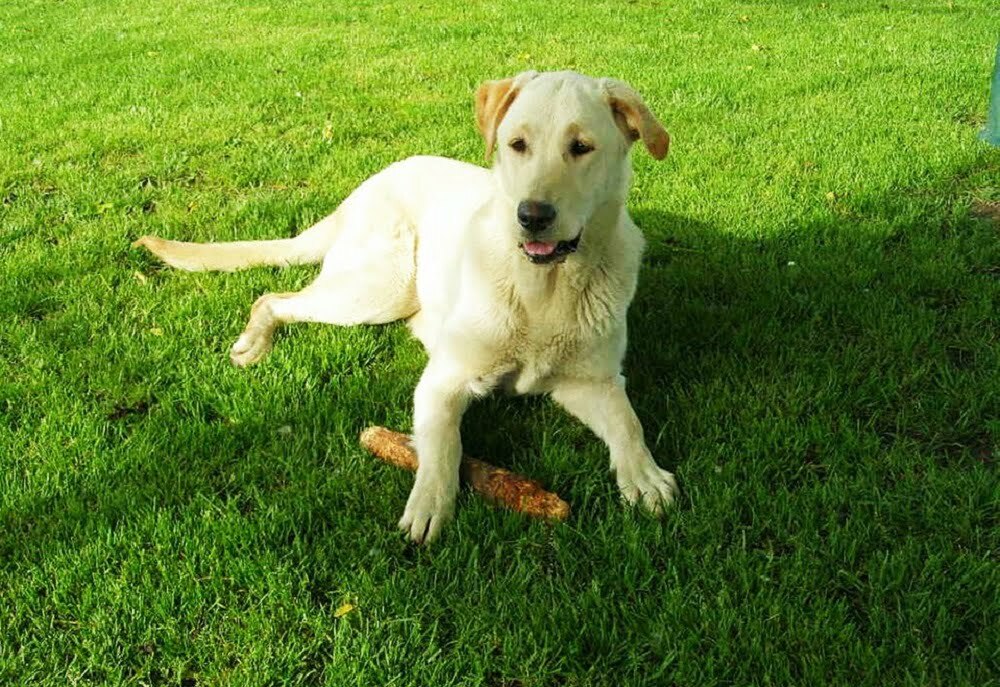Well, they are affectionate, easy to train and very loving and loyal creatures. Labradors have been used as service dogs for years, due to their kind, caring and intelligent nature. So, what is it about Labs that make them the perfect pet? Let’s find out in our Labrador Retriever: Ultimate Guide!
What is a Labrador Retriever: Key Facts

The Labrador Retriever, or Labrador is a friendly canine companion. The Lab is a working breed of dog known for its immense loyalty and love. These dogs were historically used as fishermen’s assistants, diving into the water to retrieve prey for their owners.
As an intelligent working and active breed, how did they become the most popular family dog, and reside in the homes of people all around the globe? Well, it is probably due to their very affectionate, gentle nature. This breed makes for the perfect family dog and a fiercely loyal companion.
The modern lab has moved on from hauling nets, retrieving fish and fetching ropes in the chilly waters of the Atlantic, and is now used as assistance dogs, search and rescue dogs, show dogs and family pets.
The Labrador Retriever is a sporting breed that is medium sized. These dogs tend to grow from 21 inches to 24.5 inches tall and weigh up to 80 lbs when fully grown. The most popular color of the lab is typically the yellow shade, but these dogs can also be chocolate or black, and sometimes even fox red or white!
Average lifespan:
- 10- 12 years
Minimum exercise per day:
- 60-80 minutes
Coat length:
- Short, smooth coat
Minimum cost per month:
- $85
Appearance: What does a Labrador Retriever Look like?
The Labrador is a medium sized dog, with broad shoulders, strong hind legs, and a flat, broad head. They tend to have medium sized snouts, and floppy ears. Labradors have short coats that appear yellow, black or chocolate in color, although some can be very lightly colored such as white labs, and can even be bred to be fox red or caramel in color.
The coat of a labrador is typically very dense, hard and short, as this is intended to keep them warm and waterproof in cold waters. As a result, water tends to run off the coat of a labrador. However, they do shed a lot.
This is due to their double-coat. The outer layer of hair on a labrador is waterproof, whilst the undercoat is fluffy and designed to keep the lab warm in water and all weather conditions.
They therefore shed twice a year to keep themselves cool in summer, and gain their winter coat in the latter months of the year. Labradors also have an otter tail, which helps them maneuver themselves through water!
Labs should also be sturdy, well-balanced and strong. As they are sporting dogs, bred to work, they are very muscular and athletic in build with plenty of energy and intelligence to go with it. Some labs these days are smaller in build, as they are no longer used as working dogs. Female labs can be rather small for a medium dog in some cases, compared to other lines of the breed.
As they are intended for work, they have a lot of energy and always want food. This can lead to obesity if they are not exercised enough. Labs are very, very prone to becoming overweight as they just love food. Labs will truly eat anything! Therefore, you may see a lot of chunky-looking labs, but they should be muscular and lean in appearance.
Size:
- Medium sized dog
Average height:
- Males between 22.5 and 24.5 inches
- Females between 21.5 and 23.5 inches
Average weight:
- Males between 60 and 80 lbs
- Females between 55 and 75 lbs
Temperament

Labs are known for their temperament, probably making them so popular. They have a naturally very sweet temperament and are an extremely gentle breed. They know how to behave around small children, and are aware of their size, so they often are very gentle around babies and children.
Labs also have soft mouths, they can even carry an egg in their mouths without breaking it. As a result, they can be so soft, and will very rarely bite down, even when playing.
They are very outgoing and playful creatures that love jumping, running, swimming, exploring, and remaining active. They are highly intelligent, so will love to be trained, and can be trained to a very high level, as long as there is food as a reward!
Due to their high intelligence, they are very happy, rowdy and even boisterous sometimes. They also require a lot of attention, exercise and stimulation to be happy. This means that they need at least 60 minutes of exercise a day, along with chew toys, soft toys, bones and other things to keep them occupied.
Otherwise, labs can be prone to destructive behavior. They will break things, chew through furniture or even bite through the drywall if left unattended and to their own devices. They can become bored quickly, as their brains need a lot of stimulation. This is why training is necessary for this breed for both your lab’s happiness, and your own.
Despite their playful nature, labs can also be very laid back and relaxed. Some can be rather lazy, and love to sleep all day. It can depend on the labrador and the type of lifestyle they are used to!
Whether you have a playful or lazy lab, they all come with large personalities. They love their owners more than life, and can be so affectionate, caring and respectful of their owners. Labs love to please, and will more than likely want to do anything they can to keep their owners happy. This is why they are the most popular breed of dog in the US, year after year!
Apartment living:
Labs are not really suitable for apartment living as they need a lot of exercise, and can become destructive if not properly mentally and physically stimulated.
Good for novice owners:
Yes, and no. Yes, Labs are easy to train, but this makes some owners believe that they do not need to train them. Labs require schedules and training as they are so intelligent, so as long as you are able to give up the time and patience to train your lab fully, they can be good for novice owners. If you want low maintenance for your first dog, don’t pick a lab.
Sensitivity level
Labs are very sensitive. They will not like being reprimanded, to disappoint you, or to not be receiving attention from you.
Tolerate being alone
Labradors do not really like being alone. They are very intelligent, and therefore get bored easily. Some can even develop separation anxiety, however this can be countered by ensuring that they have lots to do and toys to play with when left alone. If left alone and unattended for long periods, they can be prone to destructive or naughty behaviors.
Tolerate cold weather?
Yes, but not extreme – has double coat, and gains winter coat, but Labs are short haired.
Tolerate hot weather?
Yes, but not extreme – shed in spring/summer months, but can be prone to heat exhaustion in very high temperatures.
Affectionate with family:
Extremely loving, affectionate and loyal with family and members of the household. Can sometimes become your own shadow and will not leave your side.
Kid friendly:
Labradors are incredibly child friendly, and are highly appropriate family dogs. They are very gentle, and aware of how to behave around small children and vulnerable people.
Dog friendly
Labradors are very friendly around other dogs. They love to play and can be very boisterous. They will try to interact with and play with any dogs they come across.
Friendly towards strangers?
The downside to a lab is that they are very friendly towards strangers, which makes them perfect for having guests over, but not so good if you want a guard dog. Your Lab will more than likely lick a stranger to death rather than scare them or ward them off.
Health And Grooming
Labrador Retrievers are generally healthy dogs, as long as they have a good diet and exercise. They are prone to overeating, and can become easily overweight if they do not exercise as regularly as they should. That being said, most Labs will have a lifespan of about 10-15 years.
Labradors are prone to a few health conditions, as are all breeds, so this does not mean that all Labradors will get these medical conditions. However, Labradors can be prone to developing hip dysplasia.
This is when the thigh bone does not fit well with the hip joint, and can cause a lot of pain and inflammation. Later in life, Labradors can even become lame in one or both legs due to this condition.
In addition to hip dysplasia, Labs can develop elbow dysplasia, too. This is also an inherited condition that affects large breed dogs as the rates at which they grow can cause joint laxity in the elbow bones. Again, this can also lead to lameness and pain, so the dog should be treated by a veterinarian or medicated.
Labs love to swim in water, and explore wherever they are, and so they are very prone to ear infections. Their dropped ears can become very prone to infection as they can trap bacteria. You will have to check a Labrador’s ears weekly, and clean out any build up. Infections are common, but very easily treated with medication such as antibiotics.
Shedding
Labs shed a lot. Although they shed their coats twice a year, it can feel like they lose hair all year round. They are not hypoallergenic dogs.
Grooming
They are easy to groom, needing bathing about once a month, and brushing weekly.
Drooling
Labs are not typically drooling dogs.
General health
Labs are generally very healthy dogs, with muscular builds and active lifestyles. However they are very prone to obesity and can gain weight quickly. Keep them on a strict diet, and let them burn off calories and energy with lots of exercise. Labs should have 2.5 to 3 cups of high quality dry food a day, separated into 2 meals.
Health problems
Labs are prone to hip dysplasia, elbow dysplasia, obesity, ear infections, and eye problems.
Potential for weight gain
Labs are very prone to gaining weight as they love to eat, and will not stop when they are full. You have to ensure that your dog has a good diet, and exercises for at least an hour a day to stay in the best physical condition.
Trainability

Labs are very trainable dogs, as they are so intelligent. They will thrive from a schedule, lots of exercise, tricks to learn and jobs to do. They are willing to learn and very eager to please, which is why they are often used as service dogs, therapy dogs, search and rescue dogs or as working dogs.
They are very devoted and loyal to their owners, making them very easy to train. However, do not be fooled, you should always train these dogs despite their easy going nature! It is best to start training a Labrador as soon as you have them, or as soon as you can, as they will be much more obedient at this point, and very interested in learning new things.
Easy to train:
- Highly trainable
Intelligence
- Very intelligent
Potential to bite
- Little to none
Tendency to bark or howl
- Moderate
History Of Breed
Labrador Retrievers were first bred during the 1700s on the island of Newfoundland off the coast of Canada. These dogs were initially named St. John’s dogs after the capital of Newfoundland, and were bred to be helpers, assistants and companions of the fishermen in the area at this time.
As they were bred for a specific purpose, Labs at this time were considered working dogs, who would spend all day at the side of their owners, helping pull in fishing nets, or retrieving fish from the water. They would then return after a long day’s work and be kept at the home of the fisherman. This is why the Labrador is so prone to activities such as swimming and playing, but is also a very gentle and loyal family pet.
The actual origin of the Labrador is relatively unknown, and how they were bred is unclear. However, we can guess that the initial lab, the St. John’s dog was bred with the Newfoundland dog and other local water dogs.
Due to their popularity in the area, and how useful they were in their working lives, it did not take long for the English to import Labradors to the United Kingdom for the purpose of retrieving prey during a hunt. Later, the breed would disappear in Newfoundland, due to restrictions and tax laws on female puppies, which nearly made Labradors extinct.
Luckily, they remained popular in the UK, and became a registered breed by the British Kennel Club in 1903, and the American Kennel Club in 1917. After this, British Labradors were once again imported to the United States, where they were continually bred. Labradors remain popular today, and are still the most beloved breed in the United States, Canada and in the UK.
They are still used for working, with many being bomb detection dogs, search and rescue dogs, service animals, therapy dogs, and show dogs due to their immense agility and obedience.
Costs
Purchasing a labrador puppy can cost anywhere from $300 to $1000 depending on the breeder, and the lineage of the dog. For instance, show quality dogs will cost much more than others; some breeders are established and registered whereas others are not.
But it is not just about the initial cost of purchasing a dog, you need to buy all of the necessary supplies, such as a crate, lead, collars, bowls, toys, treats and food. The average cost per month of owning a labrador is about $85 – $100, which can cost over $1000 a year. But, you cannot put a price on unconditional love!
Fun Facts
- Did you know that Labradors have webbed toes? This is why they are such good swimmers! They also have waterproof coats and tails like an otter’s to help them swim and maneuver themselves with ease in the water. Unsurprisingly, the Lab used to be the fisherman’s best friend!
- Did you know that you can also get Fox Red Labradors and bright, White Labradors! These are much rarer than the original Yellow, Black and Chocolate Labradors.
- Labradors are from Newfoundland, near Labrador, where they got their name – who would have thought?
